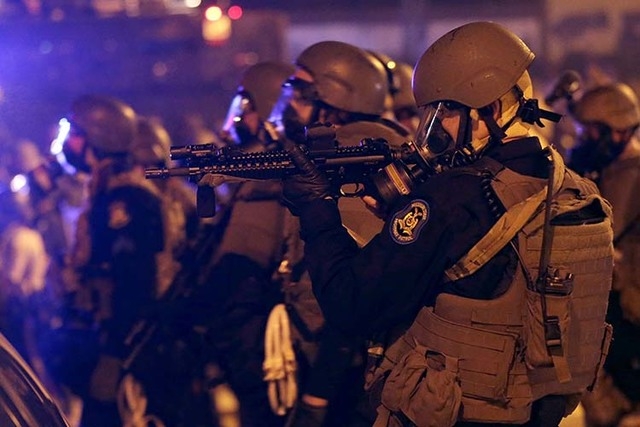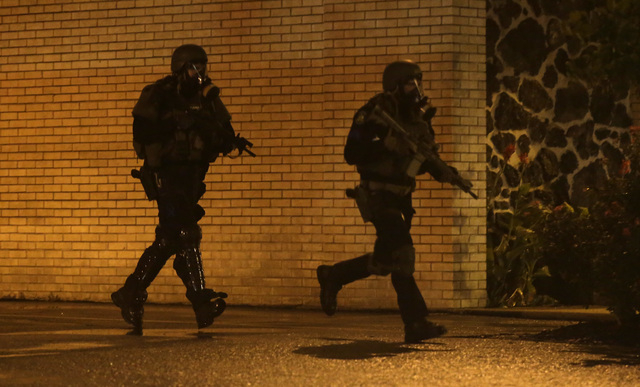Reid OK with police getting surplus weapons
WASHINGTON — As police in Missouri confront race protests with heavy arms and armor, Sen. Harry Reid said he supports allowing local forces to continue accepting surplus military weaponry, but with better oversight and training on how they are put to use.
“Whether we should allow surplus equipment from the military to go to police departments, I say yes,” Reid, D-Nev., said in a televised interview this week. “We have police departments all over the country including those in Nevada who are desperate for more resources, and the mere fact you have the equipment doesn’t mean you have to use it.
“It’s not a question of the equipment, it’s what they do with it,” Reid said. “And it’s obvious that there needs to be more oversight. Once the equipment is given to somebody, they need to have training procedures to allow them to use it properly.”
Since Reid is Senate majority leader, his views will carry weight as lawmakers set out to scrutinize the flow of assault weapons, armored SWAT vehicles, night vision goggles and even helicopters and aircraft from the military to local authorities.
The reviews are being fueled by images — inflammatory to some — of police in Ferguson, Mo., dressed in camouflage gear and toting heavy weapons in response to the protests over the police shooting of a young black man, Michael Brown.
Rep. Steven Horsford, D-Nev., said having the weapons is one thing, but it is quite another to “turn them on innocent protesters who were using their First Amendment right to express their outrage at an unarmed boy being shot down and left for dead for hours in the neighborhood where he grew up.”
Horsford said he will be attending Brown’s funeral Monday in Ferguson, at the invitation of the local congressman, Democrat William Lacy Clay, a fellow member of the Congressional Black Caucus.
Horsford said a number of lawmakers will attend “to pay our respect to the family to let them know we stand with them at this time of loss, and that we will not let Michael Brown’s death go in vain if there needs to be changes to ensure justice, fairness and transparency and to try to end racial profiling.”
Rep. Dina Titus, D-Nev., said the optics of battle-armed police as displayed in Ferguson “are very bad. They turn a community situation into a war zone.”
Yet, she said, in Clark County, police have obtained helicopter parts from the Pentagon to bolster their air rescue unit.
“I would not want to take away that ability to get those resources when your local governments already are strapped for funding,” she said.
Sen. Dean Heller, R-Nev., questioned whether police have become “overmilitarized” to where Congress should consider intervening.
“We in the Senate ought to take a look at that and some of the decisions we have made in the past and determine whether or not they are good for the citizenry,” Heller said during a joint interview Tuesday with Reid on Nevada Newsmakers, a Reno-based program.
Sen. Carl Levin, D-Mich., chairman of the Senate Armed Services Committee, has said his panel will review the Pentagon’s “1033” program that allows local police to obtain military-grade weapons and other equipment from defense surplus.
The program was established by Congress in the 1990s to allow law enforcers access to material the Pentagon would otherwise discard or destroy. So far, more than $4.3 billion worth of surplus military equipment has gone to thousands of local law enforcement agencies.
President Barack Obama on Monday also suggested that a review of the federal program might be warranted.
“It’s probably useful for us to review how the funding has gone, how local law enforcement has used grant dollars, to make sure that what they’re purchasing is stuff that they actually need,” Obama said at a news conference.
Police departments in Clark County have received more than 100 assault rifles, plus night vision goggles, bomb removal equipment and aircraft parts through the defense program. Total value of the almost 3,000 pieces of equipment was roughly $2.2 million, according to records.
Military equipment worth millions of dollars more has gone to other Nevada counties, including rifles, body armor and mine-resistant vehicles, according to an accounting in the New York Times.
Counties also can obtain a broad variety of non-lethal equipment such as utility vehicles, desks and first-aid kits.
Heller said he agreed with Sen. Rand Paul. R-Ky., who wrote in Time magazine last week that “there should be a difference between a police response and a military response.”
“Washington has incentivized the militarization of local police precincts by using federal dollars to help municipal governments build what are essentially small armies — where police departments compete to acquire military gear that goes far beyond what most of Americans think of as law enforcement,” Paul wrote.
A House vote in June killed an amendment by Rep. Alan Grayson, D-Fla., to end the 1033 program.
“Those weapons have no place in our streets, regardless of who may be deploying them,” Grayson said. “I don’t think this is the way I want my America to be. I think we should help our police act like public servants, not like warriors at war.”
Speaking against the amendment, Rep. Richard Nugent, R-Fla., said there will always be circumstances where the equipment is misused but on the whole local police act responsibly.
“It is the responsibility of those communities to keep that law enforcement agency in check,” said Nugent, a former sheriff of Hernando County, Fla. “To just outright ban the usage of that equipment would devastate local law enforcement agencies across the nation, not just in Florida, but everywhere.”
Grayson’s amendment failed, 62-355. Horsford and Titus voted to reject it, as did Nevada Republicans Joe Heck and Mark Amodei.
Titus predicted Congress might move to require further training to accompany the transfer of military equipment to local forces.
“We want to be sure it is used in the right way, for the right reasons, and that might require some additional strings to it,” she said.
Like Reid, Heck said the question should be not whether police should have military equipment but how strong are policies as to what types of weapons are used and in what circumstances.
“You don’t see cops walking a beat anymore. We don’t live in Mayberry RFD,” Heck told radio interviewer Kevin Wall on Aug. 14. The use of heavier arms might be justified “when you look at the changing dynamic of crimes being committed and how well armed the criminals are.
“For the men and women who put on the badge, they need to have the tools they need to protect us and protect their own lives.”
Heck, who is an officer in the U.S. Army Reserve and who has worked as an adviser to Clark County police, said it is an accepted practice for authorities to “show force” to try to deter individuals from acting out, a concept that might not be clearly understood.
“You don’t want police officers in that type of role to be wearing their standard polyester uniforms,” he said.
In Ferguson, “from what I’ve seen, read and heard of the level of looting, the level of violence being perpetrated even within the protests, I’m not going to second-guess what the police department is doing from 2,000 miles away,” Heck said.
Stephens Washington Bureau reporter Peter Urban contributed to this report. Contact Stephens Washington Bureau Chief Steve Tetreault at stetreault@stephensmedia.com or 202-783-1760. Find him on Twitter: @STetreaultDC.



















